I couldn't resist making my favourite Panettone again!
As I wrote previously my regular Italian sourdough has been dried up and stored away in the fridge so that I could focus on making rustic sourdough breads. I created a new, wet 100% hydration starter but the temptation to convert it into a new Italian starter was too strong. And after bringing it to maturity I couldn't resist making Panettone again!
So here we have one of my favourites courtesy of master pastry chef Igino Massari. Entitled “The Best Panettone” this is one very soft, very sweet and very moist cake!
I made dough for a 500g mould but the smallest ones I have in stock are 750g capacity. Consequently the resulting shape isn't as proud as the Milanese style. I didn't glaze it and instead cut ears…
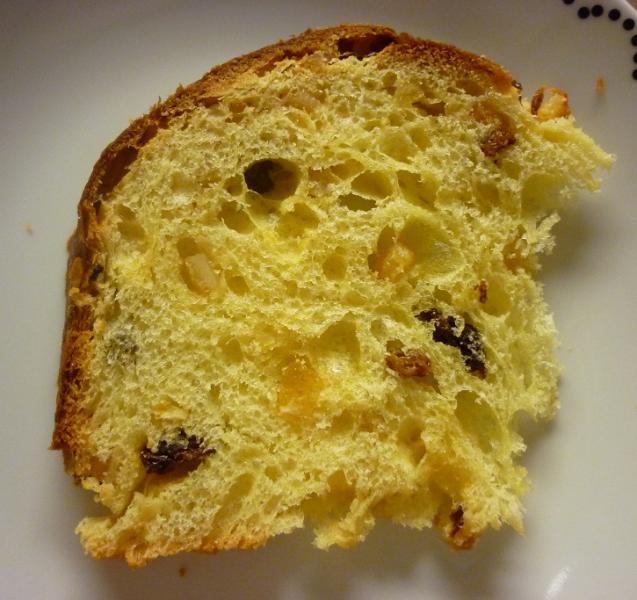
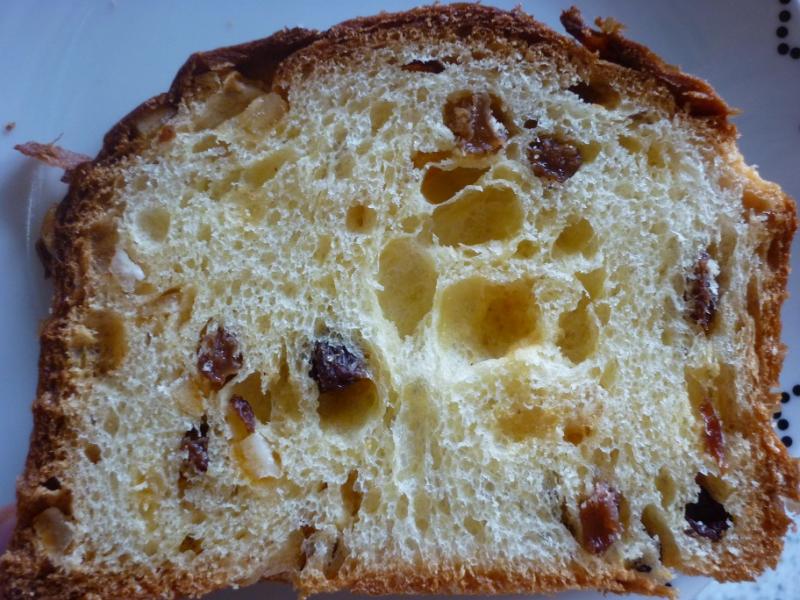
Finally, I now have a better understanding of how best to mix the second dough. I have achieved the best crumb so far. I like those open pockets!
First dough: (26C for 12hrs)
- 30g Lievito Naturale
- 120g '00' Flour
- 45g Water
- 38g Sugar
- 30g Egg Yolks
- 43g Butter
Second dough: (28C until tripled ~8hrs)
- 30g '00' Flour
- 39g Egg Yolks
- 30g Sugar
- 7.5g Honey
- 46g Butter
- 21g Water
- 2.4g Salt
- .3g Aroma Panettone
- .3g Vanilla
- 60g Sultanas
- 45g Candied Orange
- 15g Candied Citron
Total Ingredients:
| Flour | 100 |
| Water | 45 |
| Sugar | 40 |
| Honey | 4 |
| Yolks | 41 |
| Butter | 53 |
| Fruit | 70 |
| Salt | 1.4 |
| Flavourings | .6 |
| 355% |
- mwilson's Blog
- Log in or register to post comments
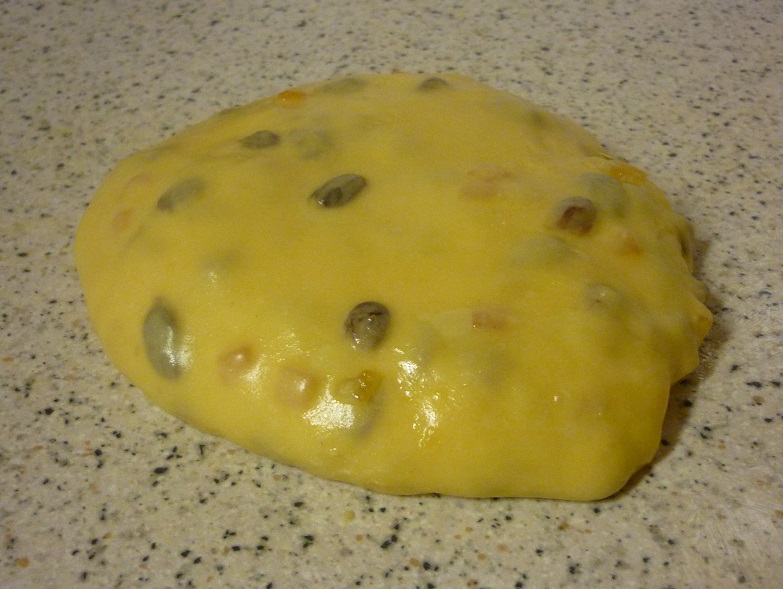
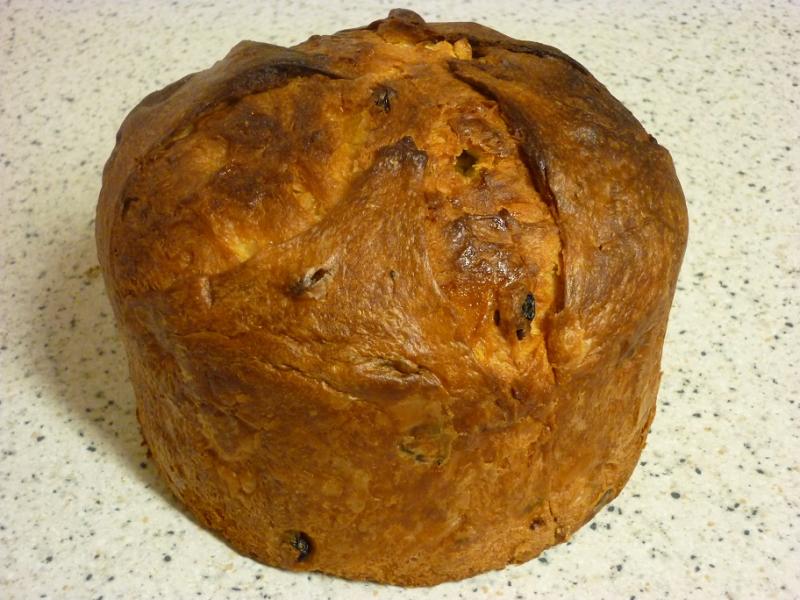
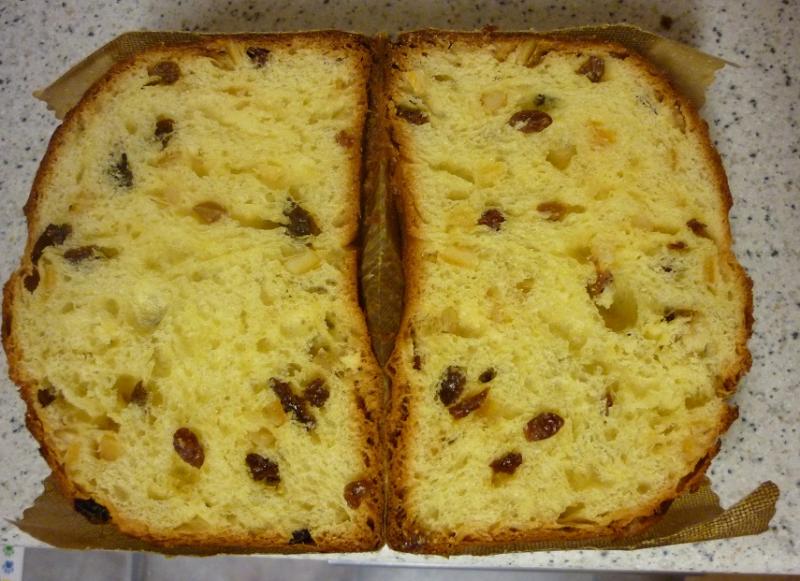
Gorgeous crumb! It looks pillowy soft. Would you be able to provide any tips on mixing the second dough, or is that a trade secret :-) ?
Thanks.
Sure. In relation to your Pandoro yolk lumps problem. Initially the flour is mixed with the first dough until reasonably smooth. Then add the yolk and sugar together in three stages, each with a small addition of butter and until well incorporated each time. Always finish the mix with the remaining butter in stages. Now all that was 'mixing'. Time for kneading, crank up the mixer and work the dough until very smooth. Adjust with water if the recipe calls for it and again work fast until ultra smooth and cleaning the bowl. Give it a rest before finally incorporating the fruit. Do this at the slowest speed or by hand.
Hope all that helps. But I would like to add that using a paddle is likely best for us home bakers as a dough hook in planetary mode is utterly useless.
Cheers,
Michael
Thanks! Do you think it would work to blend the yolks, sugar and butter into a separate, homogeneous mixture before incorporating into the dough?
You could do that but it's not really necessary.
Hi Michael,
I know that when the urge hits to do something 'bread' I am a gonner.....might as well give up trying to resist because I usually end up giving in.
Thanks for sharing where your temptation led you! Despite not being the usually tall and proud panettone loaf you mentioned I think yours looks really nice! I love the color of the crust and the ears. Looks like a package waiting to be opened. The crumb looks very nice and soft and open despite the added fruit. I can only imagine with the ingredients listed that this loaf was eaten rather quickly :-)
Thanks for the post!
Janet
Thanks Janet.
Sorry I have to play teacher for the next paragraph:
The idea that adding fruit and/or nuts to dough will compromise texture is a rather popular and inaccurate notion. As long as the dough has been worked enough, ie. good development and has good extensibility then incorporating fruit and nuts is no big issue.
I have the urge to dispel myths/inaccuracies too! :D
Yep, it's all gone! Thanks again.
Kind regards,
Michael
No apology needed. I like to be reminded of how to do certain things because I am still learning and I need my memory refreshed.
When I read your reply I instantly remembered the video of Andy cutting fruit into a dough with a bench knife once the dough had been worked enough. It shocked me because, up until then, I was under the impression that a kneaded dough had to be handled very carefully so as not to 'disturb' the gluten strands. Well, the bench knife was disturbing the gluten strands in a big way and the loaf turned out great. I tried it, cringing as I did it in my own kitchen, and was very surprised by the results. That was almost a year ago when I was making a lot of fruit and nut filled breads around the holidays and I had forgotten about the necessity of proper kneading so your reply is greatly appreciated :-)
Now I want to give your formula a try. Since you just baked this do you know off hand how much an egg yolk weighs?
Thanks,
Janet
P.S. What are the proportions in your Italian sd? I have read many different methods - one being that it is kept at a 3 to 1 ratio which I am not sure if that is 3 parts starter to 1 part new food. I would love it if you would spell it out for me in numbers. I gather it is a starter that favors yeast growth so it would be fed frequently so it makes sense that one would 'underfeed' rather than 'overfeed' at each build.
To make Panettone you really need specific temperature control and a lot of free time.
My Italian sd is a 40-50% hydration dough kept warm at 28C (82F).
You can read about it following the links on this page on my blog.
UK large egg yolks weigh about 18g. I think US large eggs are a little smaller...
Sorry for the brief reply, must go to bed now..!
to plus up the 500 recipe to 750 if you want - just to fill the pan but you could send some my way if it'w too much for you to eat:-) You are the panettone master for sure. Can't wait for the holidays to try out one of your recipes. No sense buying the crud they sell here. Nice baking as usual.
I'm converting over my new spelt starter to a kamut one so we can try a 100% whole kamut at 100% hydration based on your spelt challenge. I figure this would work for the challenge since kamut has way less protein that that easy spelt recipe you came up with :-)
I plan on having the KA mixing for 3 hours straight!
Haha! :)
This panettone is just one of many practice runs. I keep the dough small simply because of the vast amount of eggs I get through and only to use their yolks. 5 eggs just for this small 500g loaf! Unfortunately liquid egg yolk is only available in the catering industry. Eggs are the most expensive ingredient!
The Spelt challenge, now the Kamut challenge! :) Gives me an idea... How about an all spelt or kamut Panettone???
Good luck
Cheers,
Michael
panettone, covered in marmalade and whipped cream, but that is me. If I had a a bunch of egg whites laying around I might want to make a meringue out of them say and inch thick and cut the panettone the same thickness and pile them alternately on top off one another (with some marmalade on the panettone) and then encapsulate the whole shebang in a nice orange flavored, chocolate ganache. I'd call it Wilson's Delight and delight in trying to eat it too!
:) "Wilson's Delight" I like that!
Meringue's are the obvious answer with spare egg whites but they require more sugar than egg and a little goes a long way. So unless I can eat or shift a few hundred meringue nests I think the only answer is to chuck em. I feel bad about it in these hard times but what else can I do...?! A few days of egg white omelettes perhaps...
I would put a mascarpone cream on there instead. But really I just like to enjoy Panettone with a cappuccino, nothing more, nothing less... :)
panettone sounds very good. After just milling a load of kamut for the 100% kamut and hydration bread underway with a Kamut SD YW combo starter. I was surprised how yellow the whole kamut flour was and it might be a nice color for panettone. It sure soaked up the water, being 100% whole grain, in the 12 hour refrigerated autolyse. It has less protein than spelt so it might be more difficult to work but lead to a more fluffy panettone crumb in the end.
You can freeze egg whites for egg white omelettes or add them whipped stiff to cheese cake to lighten it. But merangue is the way to use them up fast. I just hate throwing food away with so many going hungry around the world. I wonder if there is a place near to donate the egg whites at a food bank, mission, church or soup kitchen for the poor?
Kamut gives a hard crumb, it's a weak and tenacious flour. Even though it's less tenacious than durum wheat it's a grain of the same league. I guess it's totally unfit for making sweet bread that have to rise 5-6 times like panettone. I suspect it would tear very soon along the way.
Spelt is far too weak and unstable for anything serious.
I think I'm mad enough to try a spelt panettone! I think it could be doable...
yesterday I baked a panettone, too!!
Yours is very beautiful, as usual MIchael.
I gathered several recipes for panettone, pandoro, colomba and veneziana in an XLS file that permits to recalculate the doses on the fly (change the blue TOTAL column and press enter to update all the partials).
http://dl.dropbox.com/u/69660061/lievitati.xls
Since last winter I prefer a different approach: a single dough risen twice and retarded in between. Unusual method, not at all traditional, but it works wonderfully!
That's cool Nico... are we going to see it?
Thanks.
I'm sure the retarding will improve the flavour and possibly the crumb.
I'm going to try a combination of flours and an autolyse to help open up the crumb...
Thanks for the file...
Michael
Here's the panettone. I haven't sliced it, yet. It's only 780 gr of dough in a tin mold larger than a 1kg paper mold!
http://www.cookaround.com/yabbse1/showthread.php?t=145214&p=4903780#post4903780
There's no fruit inside.
Thanks.
Looks good. Well domed.
Can't wait to see that crumb...
Hi Michael, here are the horrid pictures of the crumb. Sorry, but my picture genes must be seriously defective:)
http://www.cookaround.com/yabbse1/showthread.php?t=145214&p=4905772#post4905772
Hi Nico.
Looks light, but even. Reminds me of Pandoro... What strength flour/s did you use? How long was the mixing time on the second dough?
Hi Michael, I used this flour:
http://www.flour.it/Croissants-puff-pastry.htm
I had to knead more that 90 minutes because I used a different kneading sequence and I wanted to be sure that the dough had the right consistence. I also retarded the dough in the fridge overnight.
Yes, the crumb is not elongated, but frankly it has absolutely the best mouthfeel I ever obtained from a panettone. It has a perfect balance between softness and resistence. I don't repent:)
Really good to hear.
That's something I felt was lacking with mine, softness. I always get a firm set texture. Not as fluffy as commercial panettone. I'm thinking that if I use a very strong bread flour then that may help. Working on it at the moment...
I managed to decrease my mixing times significantly using a rather dangerous technique...
Michael, you know I'm as curious as a band of stray cats:-). Please, explain your technique!
I forgot to mention another peculiarity: as in many other occasions I made a single dough, not two, that is: all ingredients of first and second dough kneaded together. The retardation perfected the structure of the dough.
Lol!
Dangerous because one could easily break their mixer or lose their hand... I hold a spatula in the bowl and force it into the dough as it comes round thereby increasing the pull on the dough. Almost like a spiral mixer.
But please don't try this, I don't want you to do yourself or your mixer an injury!
All ingredients together?! Did you not have to increase the yeast quantity? I always struggle to keep things on schedule. 10-12hrs takes 14-16 for me.
I increased the starter from 60 to 80 grams. Maybe even 60 grams would have been sufficient, but I preferred to stay safe. The rise lasted 13 hours from fridge to oven.
That technique is quite risky indeed:)
was lovely but the little chefs blinking at my apprentice were unsettling and a little scary for her :-)
I can understand why you enjoy it year round. Your panettone is beautiful and so delicious looking. How do you compare making it with all purpose flour to the tipo 00? In Italy is tipo 00 used mostly in the making of panettone? I'm looking forward to making some for the holidays but would certainly enjoy it anytime. Your blogs are an inspiration.
Sylvia
Thank you Sylvia.
In Italy '00' is the flour of choice for most, if not all pastry items. Naturally leavened cakes such as Panettone require a strong, low ash flour to allow for the correct fermentation. I've not used plain flour.
Just finished a 25Kg sack of '00' and now I only have 50Kg left sitting in my kitchen!
Thanks for your kind words.
Cheers,
Michael
sorry, I was referring to King Arthur AP or Bread flours. I love using the tipo 00 flour for my baking. I'm going to try it in my Irish Soda Bread...though a little pricey for a peasant bread :) I'm sure it'll be a first.
Sylvia
That's something I felt was lacking with mine, softness. I always get a firm set texture. Not as fluffy as commercial panettone. I'm thinking that if I use a very strong bread flour then that may help.
Hi Michael, any luck softening the crumb? If not, try experimenting with diastatic malt. With the right amount, it can have that effect you're striving for.
Hi grind.
Making the switch to very strong bread flour gave me the texture I was looking for. I believe I mentioned this in my most recent Panettone post.
Hey Michael, that's great. I must have missed your post. Does Cresci get into the nitty gritty of levain builds? That's what I really want to explore - the Italian way of making levain breads.
Hard to know what you mean exactly by nitty gritty. But it tells you how to, make, maintain and correct if necessary, the natural yeast.
It's a worthy buy if Italian baking is your thing as it is mine.
But it tells you how to, make, maintain and correct if necessary, the natural yeast.
Perfect.
Hi,
I am new to the forum and been researching best panettone recipe to make..
Very much interested in terms posts on various recipes made by you..
Please advice on recipe to follow to give me good result for 500g as most I Google makes lots of loaf which I don't need.
Beautiful crumbs and all your panettone look amazing!
I'm new to baking bread and just joined this website. I have made four attempts at Panettone this past Christmas, and just yesterday finished my fourth. I tried four different recipes: Betty crocker, Laura Vitale, Bruno Albouze, and Alfonso Pepe respectively.
Each time, the final product came out defense and flat, as shown above; one time it came out dry and crumbly. I'm not sure what I am doing wrong but have ideas as to what. I think I under knead the dough before I add in the butter and sugar, but the gluten either does not develop. however, during kneading on a few attempts, the dough was elastic and smooth, but after adding butter, sugar, the dough was sticky that it stuck to my hands, and did not spring back but was easy to tear apart. Yesterday, I followed Alfonso Pepe's instructions closely, and the dough lost its elasticicity once I added butter to the Second Dough, and as well as when I added sugar, leading me to think the the gluten was either overdeveloped or not developed enough, thus not able to support the addition of sugar and butter.
This dough tastes very good, but each time I have made this bread, it has not risen to the height that it should, nor has it domed on the top. Do you have any pointers? I hope I'm clear. Colin
Hi Colin,
Welcome to TFL. From what you say I think you already have a good idea of where you are going wrong. Mixing is definitely an issue. Without seeing the dough during mixing it is very difficult to assess how you can improve. The best I can offer is that you should always take note of when the dough is "taking rope", that is to say, you can see the gluten working out, the dough becoming elastic. Only at this point will it take more ingredients.
I will add that, water attracting ingredients like sugar can be deceptive. At first they don't change the consistency much but as it incorporates in will steal the elasticity temporarily. Continue mixing and the elasticity will return.
I hope that helps.
regards,
Michael
There were points throughout the kneading process where the dough definitely did take that shape; I will look for that in the future. I'm glad I know that bit about sugar stealing elasticity temporarily. Thank you for your insights. -Colin
I want to congratulate you for such amazing job making panettone.
Making panettone has been my hobby since I was 15 and now I can finally say I am getting closer to achieve the perfect panettone with Massari’s recipes.
I was wondering if by any chance you have the book Cresci and if you could share with me the recipe for panettone a lievitazione mista. I bough the new biliangual edition but it’s missing a lot of recipes compared to the original edition.
I will appreciate your help or advice.
Thank you!
My first attempt, using Massari's recipe and process, failed before I'd even finished the First dough as I found his 400/140, flour/water ratio, too solid to accept the subsequent addition of eggs, butter and lievito.
Two questions if I may. I see you've increased slightly the water in the first stage. Is this to make the dough more workable or is it just to deal with the local flours you are using? Secondly, do you mix all the First dough ingredients in one go or do you follow Massari's method?
I'll now start to build another Lievito for my second attempt this coming weekend :-)
Thanks,
Davide
Hi Davide.
Massari has published various recipes for this type of panettone depending where you look and so the adjustments are his, not mine. This one named "The best" I have merely scaled down. There is one called "Modern Panettone" and the one I now use most often is published at dissapore.com.
Despite the very slight differences what remains consistent is the sum of the water plus half of the egg yolks always equals 50% of the flour. This seems to be a signature of Massari.
Now the method and what I think is the best way to mix the primo impasto.
First dissolve fully the sugar in water.
Add butter (soft or from the fridge doesn't matter at this small scale)
Add the flour.
Now mix until the dough starts to become elastic.
Add the lievito until incorporated.
Finish the mix with the egg yolks.
Try it this way and you might find it easier, I know I do.
Good luck,
Michael
Thanks for taking the time.
Davide
Light and airy following a good rise and it received the seal of approval from she who must be obeyed ;-)
Thanks,
Hi Davide.
Massari has published various recipes for this type of panettone depending where you look and so the adjustments are his, not mine. This one named "The best" I have merely scaled down. There is one called "Modern Panettone" and the one I now use most often is published at dissapore.com.
Despite the very slight differences what remains consistent is the sum of the water plus half of the egg yolks always equals 50% of the flour. This seems to be a signature of Massari.
Now the method and what I think is the best way to mix the primo impasto.
First dissolve fully the sugar in water.
Add butter (soft or from the fridge doesn't matter at this small scale)
Add the flour.
Now mix until the dough starts to become elastic.
Add the lievito until incorporated.
Finish the mix with the egg yolks.
Try it this way and you might find it easier, I know I do.
Good luck,
Michael
hi, mwilson.
I know this post is a bit dated but I came across it and I am curious if you still use this method for mixing the primo impasto. Ive yet to try it this way but it seems interesting especially with the butter before the flour. is this still your preferred method of mixing?
Thanks
Joe